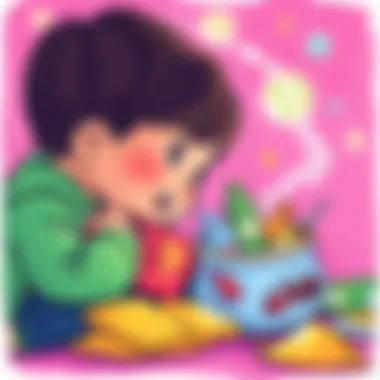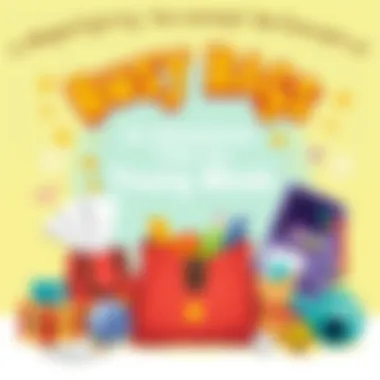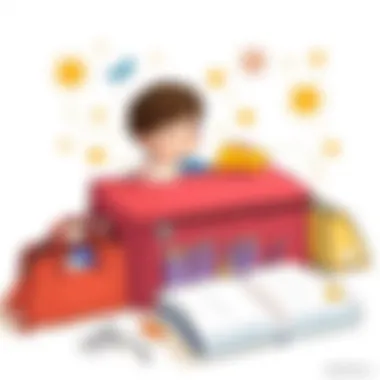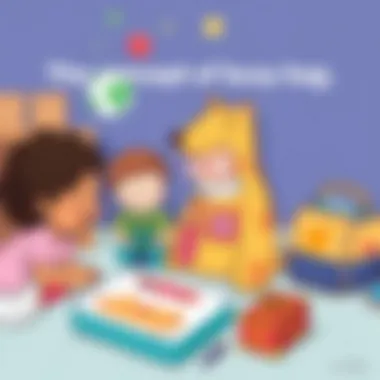Exploring Busy Bags as Educational Tools for Kids


Intro
In today’s fast-paced world, keeping young minds engaged can be a real puzzle. Parents and educators are always on the lookout for creative ways to enhance learning. This is where busy bags come into play. They are more than just bags filled with toys; busy bags are a treasure trove of hands-on activities designed for kids aged six to twelve. These bags serve a dual purpose: they keep children entertained while also promoting essential skills.
The beauty of busy bags lies in their versatility. They can be easily tailored to suit different interests and developmental stages. Packed with educational games, crafts, and puzzles, each busy bag can spark curiosity and foster creativity.
This article aims to unpack the delightful world of busy bags, detailing their immense value as educational tools. We'll explore various types of busy bags, share valuable insights on how to create them, and discuss the multiple benefits they present both at home and in the classroom.
Let's begin our exploration of this engaging concept.
Understanding Busy Bags
Busy bags serve as delightful educational tools designed to keep children engaged while cultivating essential skills through play. Their importance feels magnified in today’s fast-paced world, where learning often happens in structured, formal settings. However, busy bags provide a refreshing alternative that embraces a child’s natural curiosities. They encourage learning by doing, which often feels more impactful than just reading or listening.
Definition of Busy Bags
A busy bag is essentially a collection of activities packed into a small bag or container. These bags are filled with items and tasks aimed at engaging children in self-directed play, allowing them to explore concepts at their own pace. They typically include manipulatives—like beads, puzzles, or counting cards—that can foster critical skills like numeracy and fine motor capabilities. Busy bags can be tailored for various activities, targeting specific age groups or learning objectives. Not just any toys or games, busy bags work best when they integrate purposeful learning with enjoyment, ensuring that kids learn while they play.
Historical Context
The notion of busy bags can trace its roots back to early childhood education philosophies. The Montessori method, established by Maria Montessori in the early 20th century, emphasized hands-on learning with sensory materials. It wasn’t long before the idea permeated mainstream educational practices, paving the way for parents and teachers to create personalized learning experiences. The evolution of busy bags reflects an increasing understanding of child psychology and cognitive development, recognizing that children learn best through exploration. Over the years, educators and parents have continuously adapted these concepts to suit the evolving contexts of children's learning environments.
Purpose and Benefits
Busy bags serve many purposes and come with an array of benefits, making them a popular choice among parents and educators alike. Here are a few noteworthy advantages:
- Promote Independence: Children have the opportunity to choose activities on their own, fostering decision-making skills and independence.
- Enhance cognitive skills: Activities in busy bags promote critical thinking, problem-solving, and creativity, essential components of intelligence.
- Improve fine motor skills: Manipulative materials strengthen little fingers, promoting coordination and dexterity, vital for writing later on.
- Encourage concentration: Engaging tasks help children focus for extended periods, developing their attention span significantly.
- Facilitate learning through play: Busy bags cleverly entwine education with fun, making learning enjoyable rather than a chore.
In summary, the understanding of busy bags opens a treasure chest of possibilities for nurturing young minds. They can turn a mundane living room or classroom into an engaging playground of learning.
Types of Busy Bags
Understanding the various types of busy bags is fundamental to harnessing their potential in educational settings. Busy bags come in different forms, tailored to engage children in various ways, promoting skills that serve them in both academic and social realms. This diversity is essential for keeping each child interested and inspired to learn through play.
Themed Busy Bags
Themed busy bags have a certain charm—like a beautifully wrapped gift, they entice curiosity and foster exploration in specific topics. For instance, a nature-themed busy bag could include activities like leaf rubbings or creating a mini ecosystem with small plants. These bags let kids immerse themselves in a subject and transform learning into an adventure. When you play with the idea of themes, it allows for broadening the learning experience. A science theme could promote creative thinking through experiments, whereas an art theme could enhance fine motor skills through various crafting activities.
Subject-specific Busy Bags
Subject-specific busy bags focus on particular academic disciplines such as math, reading, or science. These bags can hold math manipulatives or comprehension games aimed at increasing subject awareness. For example, a math busy bag might feature colorful counting beads and an age-appropriate sorting game. By narrowing down on subjects, these bags offer opportunities for children to practice crucial skills while they think they’re merely playing. After all, learning is most effective when wrapped in enjoyment. It also helps children see connections between fitting areas of knowledge, leading to a more integrated understanding of the world around them.
Seasonal Busy Bags
Seasonal busy bags are a brilliant way to tap into the spirit of different times of the year. As the seasons change, so can the activities. For instance, a winter-themed busy bag might have snowflake crafts or fun, holiday-themed counting games. These bags not only keep children engaged but can also enhance their understanding of nature's cycles, cultural events, and traditions. They provide a splendid medium to talk about seasonal changes through hands-on activities. By incorporating the season into learning, children often find relevance in their everyday environment, making educational moments more relatable.
Customizable Busy Bags


Customizable busy bags are where your creativity can really shine. These bags allow parents or educators to mix and match components based on the child’s interests and abilities. Think of a base bag with some blank templates, markers, and small crafts. With these, a child could design their own projects. This fosters ownership of the learning process, nudging kids to take charge of their own education. The flexibility of customizable bags means that they can grow with the child, adapting to their changing interests or skill levels, all while keeping them engaged and eager to explore. Customizable options strike a balance between structure and freedom, allowing young learners to feel empowered.
In summation, the variety in busy bags keeps educational engagement fresh and aligned with children's ever-evolving interests. From thematic explorations to subject drives, each type plays a vital role in shaping a comprehensive learning experience. Whether at home, in educational institutions, or community settings, busy bags serve as innovative tools that spark joy and knowledge in young minds.
Creating Effective Busy Bags
Creating busy bags that truly engage and educate children is no small feat. The process requires thoughtful consideration of various factors, including the materials chosen, the educational elements incorporated, and the overall safety and suitability of the activities. Each of these components plays a vital role in not just capturing a child's interest but also in fostering a rich learning environment. When done right, busy bags become a powerful tool for parents and educators, stimulating young minds and laying a strong foundation for future learning.
Selecting Materials
Choosing the right materials is the cornerstone of crafting effective busy bags. The materials should not only be engaging but also diverse enough to cater to various learning styles and interests. It's important to choose items that are durable and can withstand the rigors of active play. Here are some pointers for selecting materials:
- Variety: Include a mix of textures, colors, and types of materials. Things like pom-poms, pipe cleaners, and beads can inspire creativity.
- Functional: Select materials that resonate with the educational goal. For example, counting bears can aid in math skills, while letter blocks can support literacy.
- Accessible: Ensure that materials are easy for children to manipulate, as too small or overly complex items could frustrate rather than engage.
Remember: Children learn best when they can touch and explore. Materials should provoke curiosity and invite exploration.
Incorporating Educational Elements
Just throwing in some toys won't cut it. It’s crucial to embed educational elements into the design of busy bags. When children engage with thoughtfully crafted activities, they are more likely to develop new skills without even realizing it. Here are some ideas for incorporating these elements:
- Clear Objectives: Each activity should have a clear learning goal, whether that's enhancing fine motor skills, promoting problem-solving, or encouraging collaborative play.
- Hands-on Tasks: Activities that require manipulation, like sorting games or building challenges, can greatly enhance cognitive and physical skills. For instance, a busy bag filled with construction blocks challenges children to think spatially.
- Encourage Reflection: Ask open-ended questions related to the activity, sparking discussion and critical thinking. This could be as simple as asking, “What happens when we mix these colors?”
Ensuring Safety and Suitability
Safety cannot be underplayed when it comes to busy bags. Children are naturally curious, and sometimes that curiosity leads them to explore in unexpected ways. Here are some key considerations for ensuring that busy bags remain safe and suitable for young learners:
- Age Appropriateness: Always select materials that are suitable for the specific age group you are targeting. For younger children, avoid small parts that can pose choking hazards.
- Non-toxic Materials: Make sure all materials are non-toxic and safe for children to handle. Check labels and do some research if necessary.
- Regular Inspections: Busy bags should be regularly checked for wear and tear. Replace any damaged items immediately to prevent potential safety hazards.
These steps may seem basic, but they are crucial in creating a safe learning environment. In the end, an effectively designed busy bag can spark imagination, boost learning, and ensure that children have a fun, yet safe experience.
Utilizing Busy Bags in Different Settings
Busy bags are versatile tools that can flourish in numerous environments. The significance of utilizing these bags in diverse contexts is multifaceted. They serve not only as sources of entertainment but also as critical learning resources, tailored to enhance cognitive development and skill acquisition in children.
Incorporating busy bags in various settings allows for the adaptation of educational strategies to meet the unique needs of children. This tailoring is key because it can create a richer learning experience. With that in mind, let's dive into specific settings where busy bags can be particularly effective.
At Home
In the comfort of their own homes, children often thrive when given the chance to explore new ideas through structured play. Busy bags facilitate this by offering a range of engaging activities that can be used during downtime, possibly during rainy afternoons or family travel times.
Some benefits of using busy bags at home include:
- Fostering independence: When children work on unsupervised tasks, they gain confidence.
- Enhancing family bonding: Busy bags can be tools for parents to actively participate in their child's educational journey, fostering discussions and collaborative play.
- Organizing time: Busy bags can help manage screen time while providing alternative activities that are both beneficial and enjoyable.
With various themes like nature exploration or art and craft introduced, busy bags can spark curiosity. Setting up a little "busy bag corner" can motivate kids to choose exciting activities rather than turning to screens.
In Educational Institutions


Busy bags find an important place in classrooms and educational settings. Teachers can leverage these tools to create dynamic learning environments where students engage with subjects in interactive ways. For instance, a science-oriented busy bag can include tasks related to simple experiments or interactive games about the water cycle.
The advantages of busy bags in educational institutions are manifold:
- Promoting cooperative learning: When children work in small groups with a busy bag, they learn to collaborate and communicate, crucial skills in today's world.
- Differentiating instruction: Teachers can tailor busy bags to suit the diverse levels of learners in their classroom, ensuring that every student can participate and benefit.
- Enhancing focus: Structured activities can help students with attention challenges by giving them clear, engaging tasks that keep them occupied and mentally stimulated.
The incorporation of busy bags into the curriculum can very much assist in building an innovative and inclusive learning space.
In Community Programs
Beyond the four walls of homes and schools, busy bags can also make waves in community programs. Libraries, daycare centers, and youth clubs can utilize these versatile bags to create enriching programs for children to explore together.
Advantages of implementing busy bags in community settings include:
- Encouraging social interaction: Children from different backgrounds can come together and enjoy group activities, fostering a sense of community.
- Expanding outreach: Community programs can introduce busy bags as part of educational outreach, reaching families who may not have access to formal educational resources.
- Supporting skill development: Activities designed in busy bags can cater to various interests, boosting children’s skills in areas like literacy, math, and even art, all while developing friendships.
In a single afternoon, children engaged with busy bags can gain curiosity and knowledge, bridging educational gaps through community interaction.
Overall, busy bags represent a flexible educational tool that fits seamlessly into the trifecta of home, school, and community, providing valuable learning moments wherever they are used.
"When children play, they are learning more than any textbook can teach. Busy bags facilitate that play, amplifying learning experiences through creative, hands-on engagement."
For more resources and inspiration on utilizing busy bags effectively, you can check Wikipedia or visit local educational blogs.
The Role of Busy Bags in Promoting STEM Learning
Busy bags not only serve as a creative outlet for children but also play a pivotal role in shaping their understanding of STEM subjects—science, technology, engineering, and mathematics. These areas are essential for nurturing innovative thinkers and problem-solvers of the future. Recognizing the importance of these subjects in the modern world, busy bags created with thoughtful consideration can engage young minds and spruce up their educational experiences. Let's explore a few critical factors why busy bags are effective tools for promoting STEM learning.
Encouraging Curiosity
Curiosity is the spark that ignites exploration. Busy bags can act as a flame for this spark, inviting children to ask questions and seek answers. Each bag can contain activities designed to pique interest. For example, a busy bag might include materials to create a simple circuit using a battery, wires, and a small light bulb.
When children delve into these activities, their innate curiosity starts to flourish. They might wonder, "What happens if I switch these wires?" or "Can I power two bulbs instead of one?" Through these inquiries, they not only discover scientific principles but also learn the value of experimentation and observation. These hands-on tasks allow kids to engage with new concepts in a tangible way, making learning less abstract and more approachable.
Facilitating Hands-on Experimentation
The hands-on aspect of busy bags makes them especially valuable in the realm of STEM. Children often learn best when they can touch, manipulate, and visualize. A busy bag filled with materials for building bridges with straws, or engineering structures with blocks, offers that crucial hands-on experience.
Moreover, they create opportunities for collaborative play. Kids can work together to solve problems—whether that’s figuring out how to make a bridge strong enough to hold weight or exploring the optimal angle for launching a paper rocket. Such interactions not only enhance their understanding of fundamental principles like balance and gravity but also teach them essential communication and teamwork skills.
Developing Critical Thinking Skills
Critical thinking is the backbone of any STEM discipline. Busy bags can lay the groundwork for these skills by integrating challenges that require thoughtful analysis. When children are confronted with tasks such as sorting objects by weight or measuring liquid volumes to achieve a specific outcome, they are compelled to think systematically and make reasoned decisions.
For instance, a busy bag could contain a simple science experiment kit where they must hypothesize about outcomes and then test their theories. This process fosters not only an understanding of scientific methods but also cultivates a mindset of questioning, evaluating evidence, and drawing conclusions based on what they observe.
"Incorporating engaging elements into busy bags allows children to build connections between playful experimentation and serious academic concepts."


Culmination
In summary, busy bags serve as more than just distractions or amusements; they can be vital educational tools that encourage curiosity, hands-on learning, and the development of critical thinking skills. Integrating these elements into a child's routine provides a rich ground for nurturing future thinkers in the fields of science, technology, engineering, and mathematics. Through the enjoyable and interactive nature of busy bags, we can effectively introduce essential concepts while allowing young minds the freedom to explore and grow.
Tips for Parents and Educators
Navigating the world of busy bags requires a keen understanding, especially for parents and educators looking to leverage these tools effectively. Busy bags can be much more than just a way to keep children occupied; they can serve as a bridge to engaging learning and exploration. By carefully curating experiences, adults can ensure these bags provide both fun and educational value.
Maximizing Engagement
To truly benefit from busy bags, engagement is key. Here are some strategies:
- Active Participation: Adults should participate in the activities alongside children. This not only models interest but also allows for shared joy and excitement in learning.
- Incorporate Child’s Interests: Tailor busy bags to what children are naturally curious about. If a child loves dinosaurs, include themed activities that revolve around that topic. It’s all about connecting the dots between play and passion.
- Variety and Change: Children are naturally inquisitive, and their interests may shift quickly. Rotate activities within busy bags to keep things fresh.
- For example, if one month focuses on animals, the following can be about space.(
Utilizing new materials takes away the mundane and keeps engagement levels sky-high.
"Children learn best when they are actively engaged and having fun. Busy bags can be a gateway to endless discovery if well-crafted and frequently updated."
Maintaining Interest Over Time
As time goes on, keeping children engaged with their busy bags can be a challenge. Here are some useful techniques:
- Create Challenges: Introduce gradual challenges that encourage problem-solving. For instance, if a busy bag includes building blocks, ask children to construct something specific over time, pushing their creative limits.
- Documentation: Encourage children to keep a learning journal where they can document their activities, feelings, or discoveries. Not only does this maintain interest, but it also instills a sense of accomplishment.
- Feedback Loop: Engage in discussions about what activities are most enjoyable or what they would like to see next. Children’s input makes them feel valued and invested in their learning journey.
Adapting Busy Bags for Different Ages
Understanding that children develop at their own pace necessitates flexible adaptations of busy bags. Here’s how to tailor them:
- Age-appropriate Complexity: For younger children, simpler tasks like sorting shapes or playing with texture might be fitting, while older kids could explore more complex tasks involving critical thinking, such as puzzles or science experiments.
- Incorporate Multiple Skills: A single busy bag can serve multiple age groups by adjusting materials. For example, simple counting beads can be used for younger kids and more sophisticated patterns for older ones.
- Group Activities: Design bags that can facilitate both solo and group play. This fosters collaboration among peers, an essential skill as children grow.
By adopting these practices, parents and educators can transform busy bags into significant educational tools that stay relevant and beneficial throughout a child's developmental journey.
For more resources on educational strategies, consider visiting ED.gov or checking out practical advice on forums like Reddit which can provide community-driven insights.
Epilogue
The concept of busy bags resonates deeply within the educational landscape, especially for the age group of six to twelve. As we’ve traversed through the nuances of busy bags, from creation to utilization, we see their significance as a transformative learning tool. Busy bags not only engage young minds but also serve as a bridge connecting education with play, fostering an environment where curiosity and creativity can flourish.
Summary of Key Points
In summary, the various aspects discussed in this article highlight how busy bags can:
- Enhance cognitive development through interactive and hands-on activities.
- Promote fine motor skills as children manipulate different materials.
- Encourage problem-solving and analytical skills essential for their growth.
- Be tailored for different themes and subjects, creating endless opportunities for learning.
- Serve to engage children at home, in classrooms, and during community programs, making them versatile tools in the educational arsenal.
Future Trends in Educational Tools
Looking ahead, the evolution of educational tools like busy bags is poised to reflect the changing dynamics of learning environments. Innovation in educational technology is likely to intertwine with traditional methods like busy bags, leading to:
- The incorporation of digital elements, where children can interact with technology through supplemented apps that enhance physical activities.
- Greater emphasis on sustainability, urging educators and parents to use eco-friendly materials for busy bags, aligning with the global shift towards responsible consumption.
- An increase in customizable options, making it easier for parents and educators to tailor activities that cater to diverse learning styles and needs.
- Collaboration among educators to share ideas and designs through online platforms, thus creating a community of knowledge sharing that supports the growth of busy bags.
As busy bags continue to play a pivotal role in early education, it is essential for parents and educators to stay attuned to these changes, ensuring that they provide the most enriching experiences for young learners. Through these ongoing developments, busy bags will likely maintain their relevance as vital educational tools.







